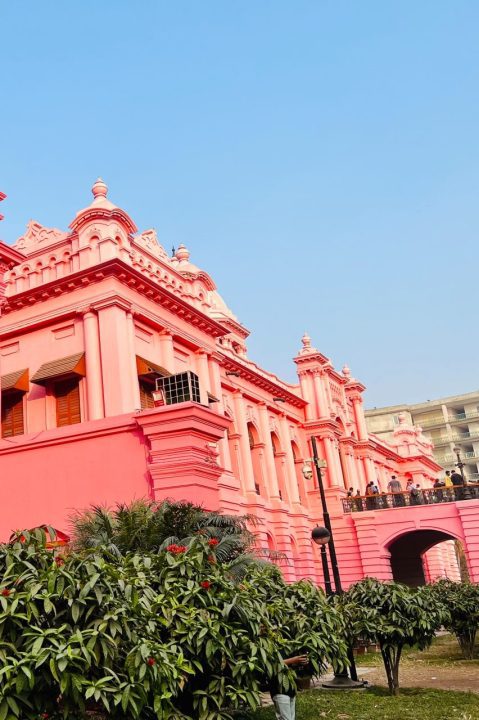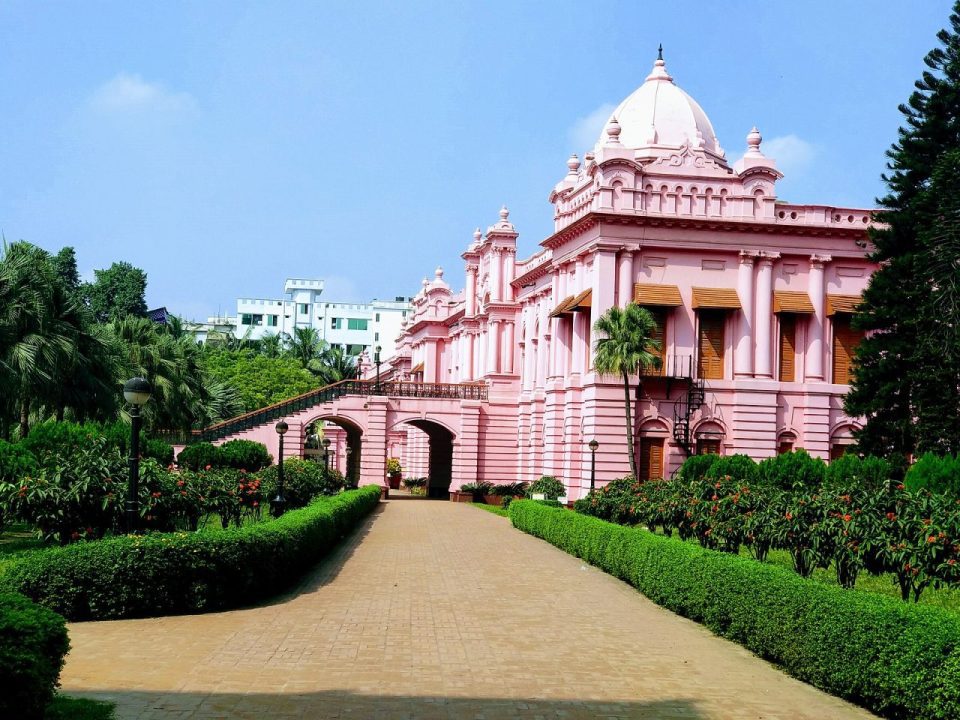Ahsan Manzil was built in 1859 by Nawab Abdul Gani, who was a wealthy merchant and philanthropist. The palace was constructed on the banks of the Buriganga River and served as the official residence of the Nawabs of Dhaka. The palace was named Ahsan Manzil after Nawab Abdul Gani’s son, Ahsanullah.
Ahsan Manzil is not only a historical landmark but also a symbol of the rich cultural heritage of Bangladesh. It has played a significant role in shaping the country’s history and culture and is a must-visit destination for anyone interested in learning about Bangladesh’s past.
Location of Ahsan Manzil
Geographic location
Ahsan Manzil is located in Old Dhaka, which is the historic area region of the city. It is situated on the banks of the Buriganga River, which adds to the charm of the palace. The palace is surrounded by other historical landmarks, cultural sites, and markets, making it a convenient stop for visitors looking to explore the city’s rich heritage.
How to get there
There are several ways to get to Ahsan Manzil, depending on your location and preference. The easiest way to get there is by taking a taxi or ride-sharing service. You can also take a bus or a rickshaw if you prefer a more local experience. If you’re coming from the airport, you can arrange for a car rental or Uber.

Architecture of Ahsan Manzil
Exterior
Ahsan Manzil’s architecture is a blend of European and Mughal styles, with a touch of Bengali influence. The palace has a pink facade and stands tall at three stories high. It has a grand entrance that leads to a spacious courtyard, which is surrounded by several rooms and halls.

Interior
The interior of the palace is equally impressive, with intricate designs and decorations that reflect the palace’s rich history and cultural significance.
Room designs
The palace has 31 rooms, each designed with a specific theme and purpose. The rooms are adorned with exquisite paintings, chandeliers, and furniture that add to their charm and beauty. Some of the rooms have been converted into museums that showcase the palace’s history and artifacts.
Decorations and furniture
The decorations and furniture in the pink palace are a combination of European, Mughal, and Bengali styles. The palace has a collection of antique furniture, including four-poster beds, chairs, and tables. The decorations include ornate carvings, colorful tiles, and intricate patterns that reflect the palace’s opulence and grandeur.
Historical significance of Ahsan Manzil
Political importance
Ahsan Manzil was not only the residence of the Nawabs of Dhaka but also a political hub during the British Raj. It was a place where political leaders and officials met to discuss important issues and make decisions that shaped the country’s history.
Cultural importance
Ahsan Manzil played a significant role in the Bengali Renaissance, a period of cultural and intellectual awakening in Bengal during the late 19th and early 20th centuries. The palace was a hub of artistic and literary activities and hosted several cultural events that helped promote Bengali literature, music, and theater.
Hosting cultural events
Ahsan Manzil was a popular venue for cultural events, including music concerts, theater performances, and poetry recitations. Many famous Bengali artists and writers performed at the palace, making it a cultural icon of its time.
Role in the Bengali Renaissance
Ahsan Manzil played a pivotal role in the Bengali Renaissance by promoting Bengali culture and literature. The palace hosted several literary societies and publishing houses that helped publish and distribute Bengali literature. It also played a significant role in promoting Bengali music and theater.

Restoration of Ahsan Manzil
Reasons for restoration
Ahsan Manzil suffered significant damage during the Bangladesh Liberation War in 1971 and was left in a state of neglect for several years. In the 1980s, the government of Bangladesh recognized the palace’s historical significance and decided to restore it to its former glory.
Restoration process
The restoration of the palace was a massive undertaking that involved several experts in architecture, engineering, and restoration. The process took several years and involved several phases, including structural repair, interior renovation, and conservation of artifacts.
Restoration team
The restoration team consisted of architects, engineers, and artisans who worked tirelessly to restore Ahsan Manzil to its former glory. They used traditional materials and techniques to repair the palace’s structure and decorated the interior with authentic furniture and decorations from the palace’s heyday.
Funding sources
The restoration of the palace was a massive project that required significant financial resources. The Bangladesh government, in collaboration with several international organizations, provided the majority of the funding for the project.
The government of Bangladesh allocated funds from its annual budget to support the restoration of Ahsan Manzil. In addition, the government received support from several international organizations, including the World Bank and the United Nations Development Program (UNDP).
The World Bank provided a loan of US$60 million to the government of Bangladesh to support the restoration of several historical buildings in Old Dhaka, including Ahsan Manzil. The loan was provided under the South Asia Tourism Infrastructure Development Project, which aimed to promote tourism in the region.
The UNDP also provided financial support for the restoration of Ahsan Manzil through its Cultural Heritage Conservation and Management Project. The project aimed to promote sustainable tourism in Bangladesh by conserving and promoting the country’s cultural heritage.
Private donations from individuals and organizations also played a significant role in funding the restoration of the historical symbol. Several local and international organizations, including the Aga Khan Foundation and the Getty Foundation, provided financial support for the project.
Challenges faced
The restoration of Ahsan Manzil was not without its challenges. The palace suffered from years of neglect and damage caused by the war, which made it difficult to determine the original structure and design. The restoration team had to rely on old photographs and historical records to recreate the palace’s original design.
Current state
Today, Ahsan Manzil stands as a testament to Bangladesh’s rich cultural heritage and history. The palace has been restored to its former glory and is now open to the public as a museum. Visitors can explore the palace’s rich history, view its impressive architecture, and learn about the cultural significance of the palace.
Visiting Ahsan Manzil
Ahsan Manzil is one of the most popular tourist destinations in Bangladesh, attracting thousands of visitors each year. If you’re planning to visit this place, here’s what you need to know.

Tour options
There are several tour options available for visitors to Ahsan Manzil. You can either opt for a guided tour or an audio tour.
Guided tours are led by expert tour guides who will take you through the palace and provide you with information about its history and architecture. Audio tours are also available in multiple languages and offer a more flexible way to explore the palace at your own pace.
Ticket prices and opening hours.
The palace is open to visitors from 10:30 am to 04:30 pm every day, except for Thursdays when it is closed. The ticket price for adults is BDT 40 (approximately USD .50), while children can enter for BDT 20 (approximately USD 0.25). For Citizens of SAARC countries the ticket price is BDT 300 (approximately USD 4) and for other nationals it’s BDT 500 (USD 7). You have to buy ticket online from Ahsan Manzil Museum.
Tips for visitors
Here are some tips to help you make the most of your visit to Ahsan Manzil:
- Wear comfortable shoes as you’ll be doing a lot of walking.
- Bring a hat, sunscreen, and water to stay hydrated during your visit.
- Respect the cultural heritage of the palace and avoid touching any artifacts or exhibits.
- Take your time to explore the palace and appreciate its unique architecture and history.
Nearby attractions
There are several other historical sites and cultural attractions near Ahsan Manzil that you can visit during your trip. Some popular options include:
- Lalbagh Fort
- Dhakeshwari Temple
- National Museum of Bangladesh
- Liberation War Museum
Food options near Ahsan Manzil
If you’re hungry after your visit to Ahsan Manzil, there are several food options available in the area. You can try traditional Bengali cuisine at local restaurants of Old Dhaka or opt for international cuisine at cafes and restaurants.
Accommodation options near Ahsan Manzil
If you’re planning to stay near Ahsan Manzil, there are several accommodation options available, including hotels, resorts, homestays, and hostels. Some popular options include:
- Hotel Ornate
- The Westin Dhaka
- Pan Pacific Sonargaon Dhaka
Souvenirs and gifts
There are several souvenir shops near Ahsan Manzil where you can buy traditional Bangladeshi handicrafts, textiles, and other souvenirs.

Safety and security tips
Here are some safety and security tips to keep in mind during your visit to Ahsan Manzil:
- Avoid carrying large amounts of cash or valuables.
- Keep an eye on your belongings at all times.
- Use a reputable taxi or ride-hailing service to get around.
- Stay aware of your surroundings and avoid going out alone at night.
- In case of an emergency, dial 999 for police, ambulance, or for fire services.
Conclusion
Ahsan Manzil is a magnificent palace that stands as a testament to Bangladesh’s rich cultural heritage and history. The palace’s grand architecture, intricate designs, and cultural significance make it a must-visit destination for anyone interested in exploring Bangladesh’s past. The restoration of Ahsan Manzil is a testament to the country’s commitment to preserving its cultural heritage for future generations.

